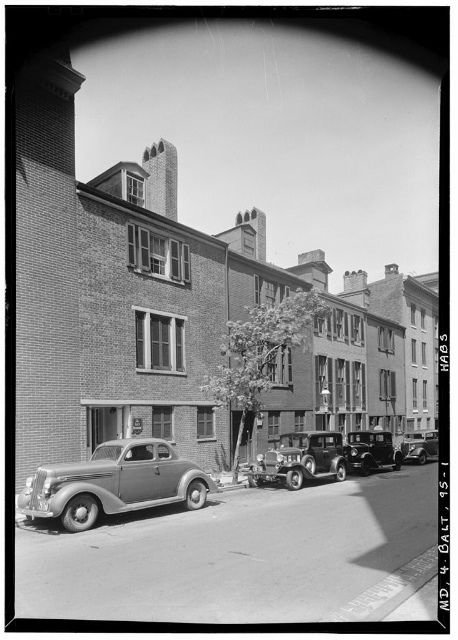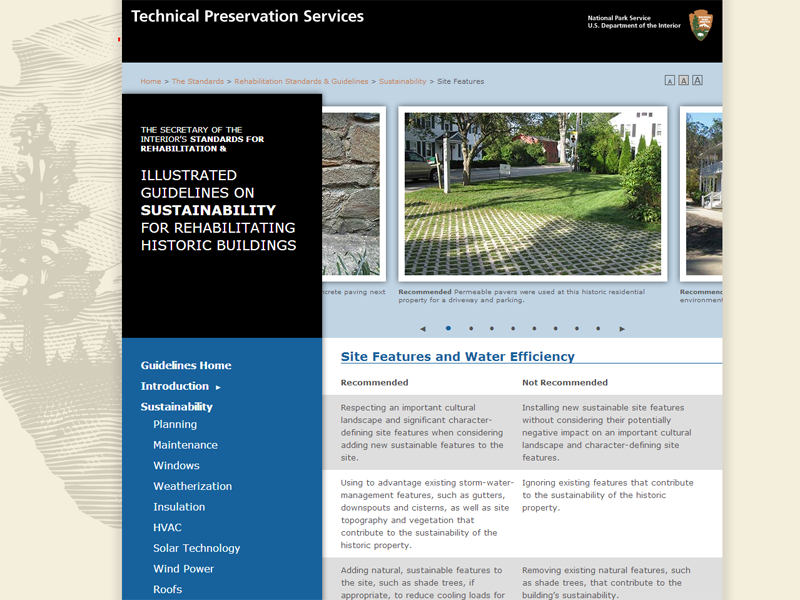Support Baltimore parks and enjoy a fun conversation about the history of parks, planning and Olmsted as we pedal together.
Author: Eli
Eli Pousson started as a Field Officer at Baltimore Heritage in partnership with the National Trust for Historic Preservation in October 2009. Prior to moving to Baltimore, Eli worked for the DC Office of Historic Preservation and completed graduate work in anthropology and historic preservation at the University of Maryland College Park. Eli continues to work with the Lakeland Community Heritage Project and other heritage organizations in Prince George’s County, Maryland.
Resource: Illustrated Guidelines on Sustainability for Rehabilitating Historic Buildings
Sustainability is a critical issue in architecture, design and planning and while we believe “the greenest building is built” we support the many home-owners and property owners who are seeking new ways to improve the efficiency and sustainability of their historic homes, apartment buildings, factories, and Main Street properties.
Thanks to the Technical Preservation Services with the National Park Service we now have an accessible and easy-to-use guide that can help historic property owners make important decisions about everything from weatherization to wind-power. The Illustrated Guidelines on Sustainability for Rehabilitating Historic Buildings offer practical guidelines with dos and don’ts on how to retrofit your home or business for sustainability. Projects that can follow these guidelines may also be eligible for state or federal historic tax credits.
You can find the Illustrated Guidelines on Sustainability for Rehabilitating Historic Buildings online or download a PDF copy of the 2011 printed version of the guidelines. If you are interested in learning more about combining historic preservation and weatherization, please join us later this month for our latest introductory workshop with Retrofit Baltimore on May 29.

Historic tax credits and weatherization workshop in Roland Park on May 29
Join us for another free introductory workshop with Retrofit Baltimore on combining weatherization and historic tax credits for your next home rehabilitation project.
Introduction to Weatherization and Historic Tax Credits
Does your old house feel a bit too hot in the spring and summer? You may want to consider weatherizing your home to improve its comfort and efficiency while saving money with historic tax credits at the same time. Join Baltimore Heritage and Retrofit Baltimore for a free one-hour workshop where you will learn more retrofitting your historic home for energy efficiency.
We’ll also tell you how to use city and state historic tax credits for weatherization or other home rehabilitation projects. If you are a home-owner in Roland Park, Homeland, Ednor Gardens, Original Northwood, or another of the over 70 historic districts across the city, historic tax credits can help you with the cost of essential home maitenance and rehab projects from re-painting to re-pointing – even furnance replacement or roof repairs. Take a look at our resource page on historic tax credits for more background then register and come to our workshop on May 29, 6:30pm to 7:30pm.
Baltimore by Bike is back! Ride through the Monumental City on Memorial Day Weekend
Join our esteemed guide Dr. Ralph Brown on a Memorial Weekend roll past a few of the highlights of the Monumental City as we remember to soldiers sailors, men and women who have served in wars throughout Baltimore history.
Historic Clubs & Cocktails! Join us for a walking tour and happy hour at the Hamilton Street Club on May 31

Established in 1925, the Hamilton Street Club occupies a pre-1820 townhouse in a row designed by early Baltimore architect Robert Carey Long, Sr. – also the architect for the Peale Museum and Davidge Hall. Among Baltimore’s private social clubs, Hamilton Street has a reputation for both intellectual conversation and irreverence. It is a place where, as Francis F. Beirne recounted in The Amiable Baltimoreans, “anybody could say what he pleased and talk as long as he pleased but nobody was required to listen.”
The club’s popularity among by local writers, as well as journalists and editors from the Baltimore Sun, led long-time club president and owner of the Victor G. Bloede Chemical Co. William W. Woollcott to remark, “Here I am, the only businessman in the club, surrounded by parasites.” Join us at the club on May 31 for food, drinks and great conversation with fellow preservationists, including a chance to meet a few of the club’s long-time members.
Bonus! Walking Tour of Mt. Vernon’s Historic Clubs
Work up a thirst before the happy hour with a quick stroll through the history of private social clubs in Mt. Vernon. On a short walk from Mt. Vernon Place to the happy hour, we’ll share stories of Confederate sympathizers, tireless social reformers, and the most serious of university scholars from the neighborhood’s private social clubs from past and present. The tour begins at 6:00pm in the north park of Mt. Vernon Place by Charles and Madison Streets.

